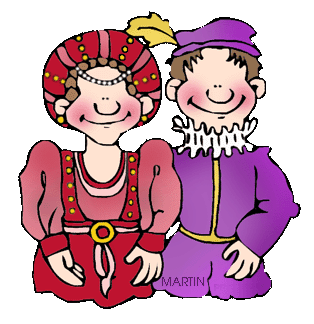
The Tudors for Kids
The Tudors for Kids
The Tudor era was 1485-1600. It's called the "Tudors" after the Tudor family, who were the kings and queens of England during this time. King Henry the 8th and Queen Elizabeth 1 were both royal members of the Tudor family. Although towns were beginning to spring up and grow, most of the population during Tudor times lived in villages. They were farmers.
Villages: Villages during Tudor times had many similarities. Nearly all had a church. Typically, the church was the largest building in the village. When services were not in session, the church was used to house livestock, so the floor of the church was usually covered with straw. Many villages had a town hall. This was a simple building where elected officials met to discuss whatever needed to be discussed about village matters. Each village usually had a candlestick maker, a tanner (who tanned animal skins), and a mill to grind grain. Some of the larger villages had a theatre where live plays were performed. People enjoyed market day, when they brought their goods to town to sell. The church offered many activities. And, it was still a time of knights and jousts, which were always popular. Life was tough for most; people worked very hard growing food, caring for cattle, and making clothes and other things they needed.
Social Scale:
-
At the bottom of the social scale were peasants, tenant farmers. Peasants were extremely poor, and life was tough for peasants as it had been for centuries. B
-
There was a new class of social scale - the yeoman. Yeoman were a step above peasants. Yeoman's were landowners, or had jobs for the nobles. Many had tenant farmers who tilled their personal land. Yeoman were usually pretty rich. Yeoman houses were built with two stories, a brick chimney, several rooms, and wood furniture. The first floor was the sitting room, dining room, and kitchen and perhaps a getaway room for the husband. The second floor was bedrooms. Some yeoman homes had a separate barn to hold animals and store straw in the winter. They had a well for water.
-
At the top of the heap were the nobles, the lords and ladies.
School: Many Tudor children, both boys and girls, learned to read and write. If you misbehaved, you were beaten. Sons of the rich might go on to university at either Oxford or Cambridge. Those who did not go to university might work in the towns as an apprentice for 7 years, learning a trade. Some boys stayed in the village and remained farmers.
Clothing: Clothing was very important during Tudor times. You were supposed to be able to identify someone's social class by their clothing. There were laws that said what materials you could use to make your clothes depending upon your wealth status. Only the very rich could wear silk with gold or silver embroidery thread. Rich women wore silk stockings. Clothing became more practical as families were less wealthy, with linen clothes in the summer and wool clothes in the winter. For the poor, clothes had to be tough, made of coarse and scratchy wool. Hats, however, were worn by everyone. Still, the material that made the hat, and the hat design itself, was controlled by law. Some people ignored the law and wore what they wanted. They risked punishment, and punishment during Tudor times was quite severe.
Medicine: During Tudor times, most doctors were expensive and many were not very good. Doctors had little understanding of disease or of the human body and how it worked. Medical solutions to illness could cause more problems than they cured.
War: War changed dramatically. The longbow went out of use because guns were invented during Tudor times. Guns took a long time to load, so warriors also carried pikes - long spears, to protect themselves.
Food: At least they ate well during Tudor times, at least they did on the farms, in the villages. Food could be scarce, however, for the poor in the towns. The rich had the finest food as usual. There were new foods from the New World brought back by explorers, foods like potatoes, chocolate, peanuts, pineapple, vanilla, tomatoes, and turkey.
The Terrible Tudors & Vile Victorians
For Teachers